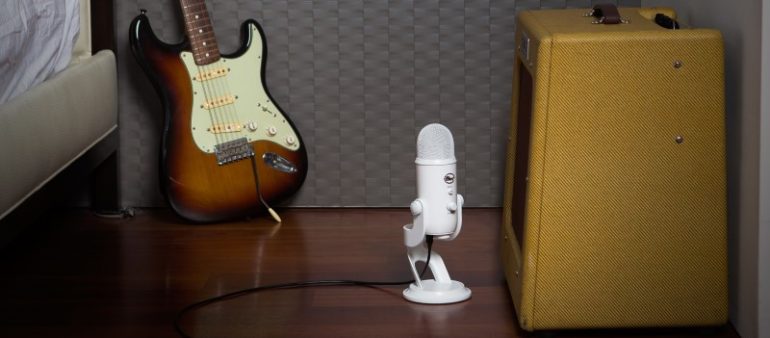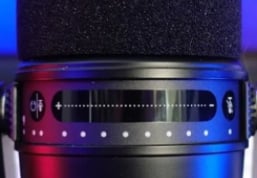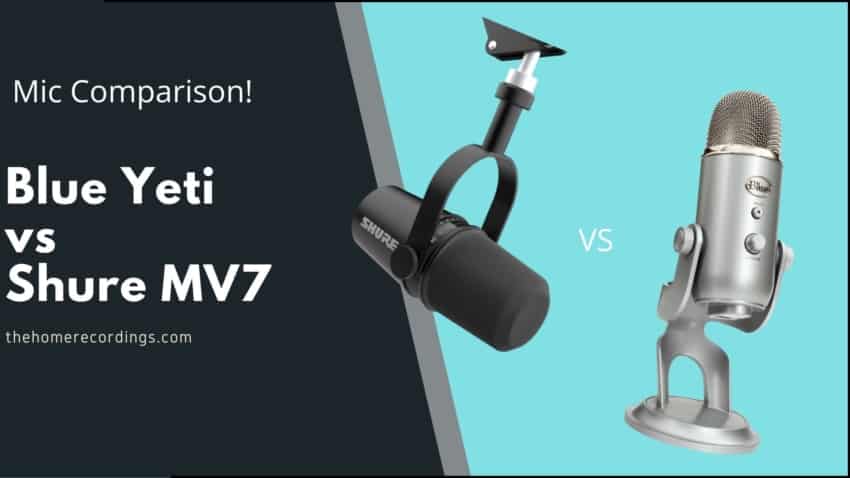Last updated on December 29th, 2023 at 09:54 pm
If there’s one USB mic dominating the market for years, it’s got to be the Blue Yeti. But is it really that great? Is the Shure MV7 a better option? Are they similar microphones? What’s the difference between the two and which one should you get?
In this article, I will answer all those questions as well as give you a small list of other USB mic alternatives that might suit your needs better.
So, without any further ado, let’s get started!
In short, the differences between the Blue Yeti and the Shure MV7 are: The Blue Yeti is a USB condenser microphone that has four polar patterns (cardioid, omnidirectional, stereo and bidirectional), whereas the Shure MV7 only offers a cardioid polar pattern but comes with USB and XLR connectivity, it sound better, especially in the low end, and it features a software for controlling the sound even further.
Let’s now jump straight into the post, starting with the Blue Yeti!
Blue Yeti

Blue is known for making excellent quality, cool-looking and VERY expensive microphones. Luckily, the Blue Yeti won’t break the bank.
It’s their most famous microphone which works through USB and is plug n’ play, meaning that all you need to do is connect it and that’s it, it’s ready for use, and it will work perfectly on both Windows and Mac OS.
The build quality is great, it feels very durable and not like some cheap microphone that seems as if it’s going to break anytime soon. However, I have to mention that it’s a gigantic microphone and it might get in the way if you set it up on the desk using the included desk stand.
It features a multitude of pickup patterns like cardioid, omnidirectional, stereo and bidirectional, which makes the Blue Yeti quite versatile, especially for the price.
It is not only an excellent microphone for podcasters, YouTubers and Voice-over artists, but it’s also pretty good for recording music… emphasis on pretty good.
This microphone also comes with a Gain control, mute button and a zero-latency headphone output, which is on the bottom.
All the knobs are easy to use, and you can quickly tell how much- or how little gain you’re dialing in.
The reason the Blue Yeti is a good option for recording music is, apart from its good sound quality, that it can record in stereo.
Why is the stereo pattern so useful?
We usually record acoustic guitars, pianos, etc. using two pencil condenser microphones which, when combined, give us a really nice stereo feel.
While the Blue Yeti won’t give you the exact same results as the two pencil microphones, it will certainly give you a better result than using a single cardioid microphone, at least in terms of stereo feel.
Another plus is that if you already own a cardioid microphone you can use the omni setting on the Blue Yeti and record with both of them at the same time, using the mid-side technique which is an excellent way of creating a stereo recording.
How does it Perform?
The Blue Yeti is very easy to use and doesn’t require any technical knowledge to be configured, just connect and use without the need to worry about any drivers or latency issues.
The sound quality is very good considering the price, plus having four different pickup patterns allows for a lot of versatility.
Do you need to record a bunch of people for a podcast? Or do you need to record and ensemble? Or maybe you just want it to have a conversation over skype… With all of these pickup patterns you can easily do all of this without any issues.
I liked it especially for voice-related applications but, like I mentioned earlier, not so much for recording music.
This is because, even though the stereo pickup pattern can come in handy when recording something like an acoustic guitar, I just didn’t like the way it sounded as much; It doesn’t sound as bright as I would have hoped, which is why I said that it sounds “good” and not “great”. It kind of lacks personality.
Don’t get me wrong, it’s a great microphone and it’s super worth the money, plus someone with an untrained ear probably won’t even notice these subtleties.
If you want a good microphone for a podcasting project or simply for making YouTube videos, then I think that you should choose the Blue Yeti, especially if you are going to use the different pickup patterns.
What comes in the Box?
- The Blue Yeti Microphone
- USB Cable
Features
- Tri-capsule array: three condenser capsules inside
- Multiple pattern selection: cardioid, stereo, omnidirectional and bidirectional
- Gain control, mute button, zero-latency headphone output
- Perfect for podcasting, voiceovers, game streaming, interviews, conference calls and music recording
- Plug ‘n play: Mac and PC compatible
- Desk stand included (already attached to the mic)
Specifications
- Polar Pattern; Cardioid, stereo, omni- and bidirectional
- Frequency Response: 20Hz- 20kHz
- Sample Rate: 48kHz/16-bit
- Max SPL: 120dB
- Weight: 1.2 lbs
If you’re looking for a versatile microphone, then it might be a good idea to go for the Blue Yeti.
Find out more about the Blue Yeti here.
- Blue Yeti: Amazon, Sweetwater.
Shure MV7 Overview

The Shure MV7 is a relatively new mic that seems to have been designed to bridge the gap between the more affordable USB microphones and the almighty SM7B, which is the standard podcasting mic that sells for roughly $400.
The Shure MV7 looks very similar to the SM7B and it’s also a dynamic microphone, which is not that common for USB microphones since most of them are condensers, and this means that it generally won’t pick up as much background noise, making it a good choice for anyone who is running a podcast or gaming at home where there might be some noise.
The most important feature of the Shure MV7 is that it not only features a USB connection, but an XLR one as well, and if you read any of my other USB mic-related articles then you probably know that, while I like USB mics and I think that they have their place, they don’t offer an upgrade path and you will end up spending a lot more once you move on to a more professional setup.
With the Shure you can simply buy a Mixer or an Audio Interface and won’t have to worry about not being able to use it since you can simply connect it to the mixer using an XLR cable.

Another distinctive feature is its interactive touch panel on the top which lets you control the audio level, the monitor mix, and you can tap it to mute/unmute the mic and the headphones. While I do think that this is a really modern way of doing things, I don’t know if a touch panel will last longer than knobs, so we’ll have to wait and see.
Lastly, it comes with the ShurePlus MOTIV software which comes with a lot of features that podcasters and gamers are going to enjoy, such as:

- Control the gain automatically or do it manually.
- Change the tone from Dark to Natural or Bright.
- Adjust the monitor mix.
- Adjust the audio “view” of the mic, such as “Near” and “Far”.
- Manual mode lets you adjust the gain, the monitor mix, it offers some basic EQ, a limiter, and a basic compressor.
The EQ and compressor only offer basic settings that you can turn on or off, like High-Pass filter, presence boost, etc., and don’t really give you a more granular control over the signal.
The Limiter is an excellent feature to have, especially for podcasters and gamers, since they prevent loud audio spikes, which could easily jump scare your audience.
What comes in the box?
- Shure MV7 USB/XLR Microphone.
- Micro USB to USB-C cable.
- Micro USB to USB-A cable.
Features
- USB and XLR connections.
- Touch Controls (no knobs).
- Dynamic microphone (better for background noise).
- ShurePlus MOTIV software for better control over the audio signal.
How does it sound?
This mic reminds me a lot of the way the Shure SM7B sounds, especially in the low end since it makes your voice sound deep and really full, which is why I think that it’s especially good for podcasters. Other than that, it sounds really balanced and I don’t think that there’s anything that stands out as “bad”, like no frequencies poking their head out too much.
As far as recording music goes, it actually surprised me quite a lot since recording my acoustic guitar sounded full but not boomy, and the higher end had a nice open airy sound to it. Overall, quite impressed.
One thing that I don’t particularly like, however, is the foam pop filter, especially for being such an expensive microphone, since I feel like it doesn’t really do that much in terms of reducing the plosives. It’s super thick on the sides but the top is extremely thin (hold it up against a light and you can almost see right through it).
I don’t know why they went with this design, maybe a thicker pop filter affected sound quality? I don’t know, but it doesn’t work as well as I would’ve hoped.
So, either offset it when recording (off axis) and see if you like how it sounds, or find a way to put a pop filter in front of it.
Also, it doesn’t come with a built-in shock mount, so taping on the desk, keyboard, or just accidentally bumping up against the boom arm/tripod, will transmit all of that vibration into the mic.
Specifications
- Polar Pattern; Cardioid
- Connectivity: XLR and USB
- Frequency Response: 20Hz- 20kHz
- Sample Rate: 44.1/48kHz/16/24-bit
- Max SPL: 132dB
- Weight: 550g
Find out more about the Shure MV7 here.
- Shure MV7: Amazon, Sweetwater.
Which one should you go for?
I honestly think that the Shure MV7 sounds a little better, especially when you get up close (although the plosives might be an issue there), which is why I think that it’s an absolutely fantastic microphone for podcasters, and since it’s got an XLR connection as well, you won’t need to buy a new mic once you upgrade the rest of your equipment, overall saving money.
The Blue Yeti costs about $100 less and does offer more versatility because of the different polar patterns, but generally speaking, we only record using the cardioid one, so those extra patterns might be wasted.
I think that it all comes down to budget and upgradeability: Do you plan on upgrading your setup at some point and purchasing a mixer or an audio interface with more inputs? Then get the Shure MV7 since it’s going to be more affordable in the long run, even if it costs $100 more.
If you like the idea of having multiple polar patterns (maybe you want to start a podcast on the cheap and simply place the Blue Yeti on the table in the omni setting), or if you don’t think you’ll be upgrading your equipment any time soon, then the Blue Yeti is the better choice.
Other alternatives
I reviewed a couple USB mics already and there are two that stand out: The Audio-Technica AT2020+ USB, the ElGato Wave 3, and the Samson G-Track Pro.
The AT2020+ USB sounds great, better than the Blue Yeti in my opinion, but it only features a cardioid polar pattern. Still, it’s way cheaper than the Shure MV7.
The Elgato Wave 3 is a relatively new mic that was designed specifically for games since, similar to the Shure, it comes with included software designed to help you better control the signal (compression, limiter, it lets you manage and mix the level of different audio signals, such as music playing, the stream’s volume, mic volume, etc.).
The ElGato Wave 3 is also much more affordable than the Shure but it doesn’t feature an XLR connection, so the same concept about upgradeability applies here.
The Samson G-Track Pro is an interesting alternative, mainly for guitarists and bassists since it features an instrument jack that lets you record both the microphone signal and the instrument signal to separate tracks, and you can even use it with amp simulation software with very low latency.
Conclusion
If I had to choose, I’d go with the Shure MV7 mainly because of the XLR output since you never know if you’re going to need to upgrade later on and, if you do, you will end up saving money and not have a USB microphone laying around collecting dust.
The Blue Yeti is a good option for anyone on a budget, but I don’t think that having multiple polar patterns really makes it that useful or better when compared to cardioid microphones.
If you want a good and affordable USB microphone, go with one of the three I linked above, if you need a fantastic podcasting mic that offers an excellent upgrade path, then go with the Shure MV7.
